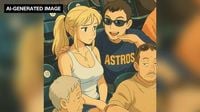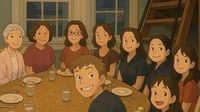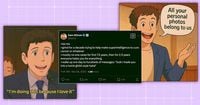In the wake of OpenAI's recent launch of its advanced image generation capabilities with GPT-4o, a new social media trend has emerged, showcasing AI-generated images that imitate the iconic style of Studio Ghibli. This phenomenon has captured the attention of both fans and critics, leading to discussions about the implications of AI in art and copyright issues.
Since the rollout of GPT-4o on March 25, 2025, users have flooded platforms like X and Instagram with AI-made cartoons that mimic the aesthetic of beloved Ghibli films, such as "Spirited Away" and "Howl's Moving Castle." OpenAI CEO Sam Altman even joined in the fun, changing his profile picture to a Ghibli-style image of himself, further fueling the trend.
However, the excitement surrounding this trend has been met with a twist. Reports indicate that ChatGPT has started refusing requests to generate images in the Ghibli style, as noted by Business Insider. An OpenAI spokesperson stated, "Our goal is to give users as much creative freedom as possible," while also emphasizing that they prevent generations in the style of individual living artists but permit broader studio styles.
The Ghibli trend raises significant questions about this policy, particularly since Hayao Miyazaki, the legendary director behind many Ghibli classics, is a living artist. Miyazaki has previously expressed his disdain for AI-generated art, calling it an "insult to life itself." In a 2016 documentary, he stated, "Whoever creates this stuff has no idea what pain is whatsoever. I am utterly disgusted." This sentiment has led to a complicated relationship between the burgeoning AI art movement and the established norms of artistic creation.
As users continue to experiment with the new capabilities, some have recreated scenes from popular culture and politics in the Ghibli style. Viral posts have included reimagined trailers for "The Lord of the Rings: The Fellowship of the Ring" and scenes from "The Sopranos," alongside Ghibli-inspired memes like the "distracted boyfriend" and "bro explaining" memes. One particularly popular post depicted Elon Musk playing with cutlery, based on a recent viral video.
Despite the excitement, the trend has sparked backlash from some artists and fans who feel that AI-generated images are infringing on the creativity and originality of human artists. Just weeks prior to the Ghibli trend, nearly 4,000 individuals signed an open letter urging Christie's auction house to cancel a sale dedicated solely to AI art, citing concerns over copyright and the exploitation of human creativity.
In light of the recent developments, Altman acknowledged the viral interest in Ghibli images, joking on X about the contrast between his work on creating superintelligence and the sudden popularity of AI-generated Ghibli art. He remarked, "Mostly no one cares for first 7.5 years, then for 2.5 years everyone hates you for everything. Wake up one day to hundreds of messages: 'Look I made you into a twink Ghibli style haha.'" This humorous take underscores the unpredictable nature of public interest in technology.
As the dust settles on the Ghibli trend, many users have found ways to engage with the style, despite the limitations imposed by ChatGPT. OpenAI announced that it would roll out the image generation capabilities to Plus, Pro, Team, and Free users, although the rollout for Free users has been delayed, and they will be limited to three image generations per day. For those eager to create Ghibli-style images without the subscription fee, alternatives like Elon Musk's Grok AI, based on Grok 3, are available, albeit with less accuracy than ChatGPT.
In the broader context of AI and art, the Studio Ghibli trend serves as a reminder of the ongoing debate about the role of technology in creative fields. While AI has the potential to enhance artistic expression, it also raises ethical questions about originality and ownership. The balance between innovation and respect for traditional artistry remains a critical conversation in the evolving landscape of digital creation.
As OpenAI continues to refine its policies and technologies, the future of AI-generated art remains uncertain. With the company acknowledging some mix-ups in its content policy, including refusals of certain generations that should be allowed, users are left wondering how these changes will affect their ability to explore creative avenues. The Ghibli trend is just one of many examples illustrating the complexities and challenges of integrating AI into the world of art.
As we look to the future, the intersection of technology and creativity will undoubtedly continue to provoke discussion and inspire both excitement and concern among artists, technologists, and audiences alike. The legacy of Studio Ghibli, characterized by its rich storytelling and hand-drawn animation, will remain a touchstone as the dialogue around AI-generated art evolves.



